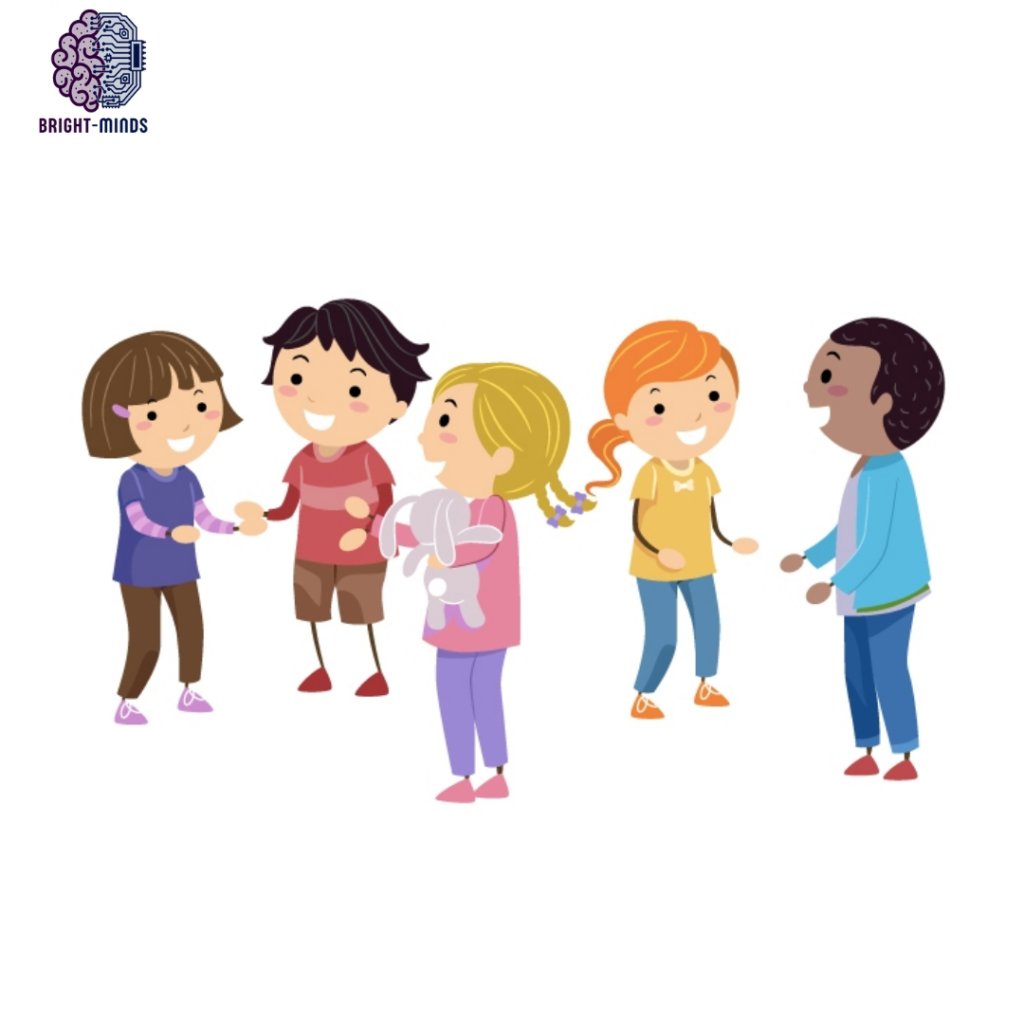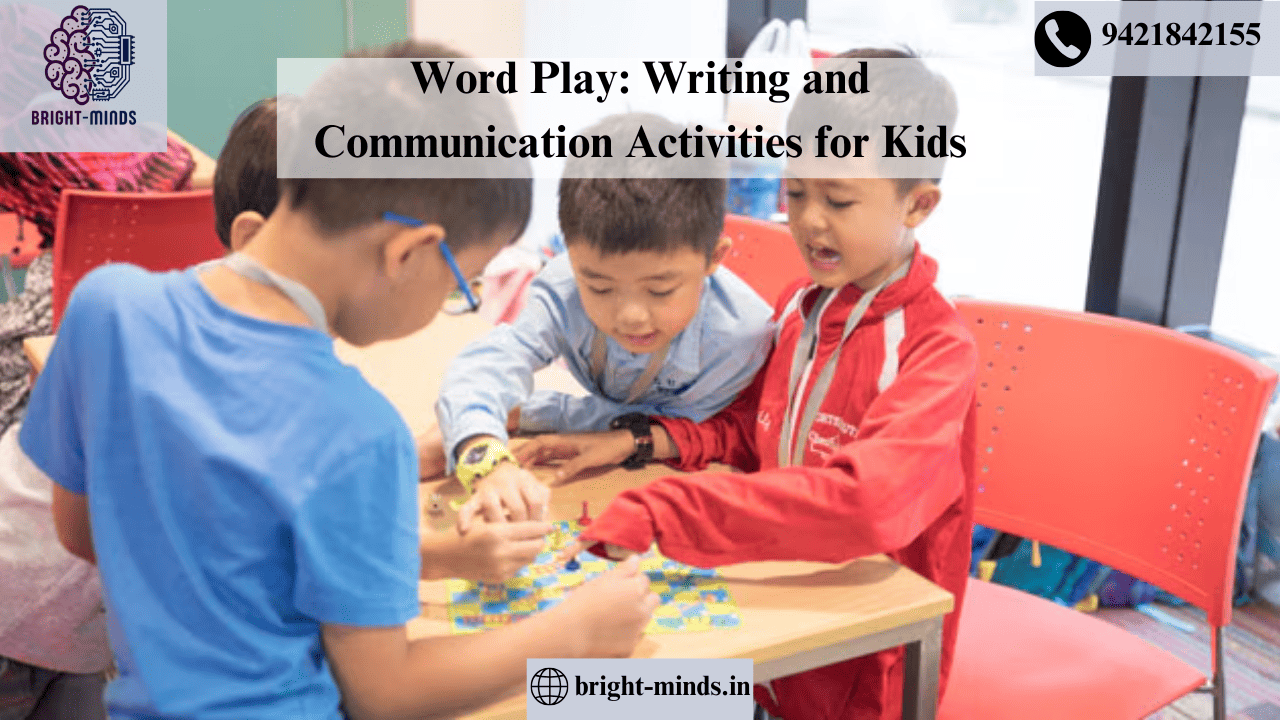Language is a powerful tool that shapes how children express their thoughts, ideas, and emotions. For kids, learning to communicate effectively through writing is a crucial skill that fosters creativity, critical thinking, and social interaction. Writing activities not only help children become better at expressing themselves but also enhance their overall communication skills, both verbally and non-verbally.
In this blog, we’ll explore fun and engaging writing and communication activities that will inspire children to play with words. These activities are designed to boost creativity, improve vocabulary, and encourage children to think critically as they communicate through writing.

1. Story Starters
Story starters are a great way to spark children’s creativity and encourage them to think outside the box. By providing the beginning of a story or a prompt, you can help kids develop their own narrative, allowing them to practice their writing skills while also improving their communication abilities.
How to Play:
- Provide a sentence or short paragraph that starts a story, such as “Once upon a time, a little bird flew into the biggest tree in the forest…”
- Ask the children to continue the story, using their imagination to create characters, settings, and plot twists.
- Once they’ve finished, they can share their stories with the group, encouraging verbal communication as well.
Benefits:
- Enhances creative thinking and imagination.
- Encourages children to structure their thoughts logically and coherently.
- Helps improve writing skills and storytelling techniques.
2. Word Association Game
The word association game is a simple but effective way to expand vocabulary and build connections between words. It encourages children to think quickly and creatively, improving their communication and writing skills at the same time.
How to Play:
- Start by saying a word, such as “apple.”
- The next child must say a word that is related to the first word, such as “fruit.”
- The next child then says a word related to “fruit,” such as “banana.”
- The game continues in a circle, with each player responding with a related word.
- If a child can’t think of a word or repeats a word, they’re out for that round.
Benefits:
- Expands vocabulary and encourages quick thinking.
- Helps children learn to make connections between words and concepts.
- Encourages verbal communication and listening skills.
3. Alphabet Stories
The alphabet story activity encourages children to practice their writing skills while challenging them to think creatively. It helps improve communication by requiring children to focus on sentence structure and word choice.
How to Play:
- Ask the children to write a story where each sentence starts with the next letter of the alphabet. For example:
- A: “A little boy found a mysterious box in the garden.”
- B: “Beneath the box, there was a secret map.”
- C: “Curious, he decided to follow the map.”
- The story continues through the alphabet, with each sentence starting with the next letter.
Benefits:
- Enhances creativity and critical thinking.
- Helps children focus on writing clear and meaningful sentences.
- Encourages a fun and structured approach to writing.
4. Picture Prompts
Picture prompts are a fantastic way to get children thinking and writing creatively. By observing an image, children can develop their imagination and practice describing scenes, characters, and events. This activity can also help improve communication as children express their thoughts through writing.
How to Play:
- Show the children a picture, such as a photograph, drawing, or illustration.
- Ask them to write a short story or a description based on what they see.
- Encourage them to think about the scene, characters, and what might happen next.
- Once they finish writing, they can share their stories with the group.
Benefits:
- Develops imagination and descriptive writing skills.
- Helps children practice using sensory details to convey emotions and settings.
- Encourages clear and concise communication.
5. Word Search and Create
A word search can be both fun and educational. After completing the word search, children can use the words they find to create sentences or stories. This activity encourages them to connect words in creative ways, which helps build their vocabulary and writing skills.
How to Play:
- Provide a word search puzzle that contains a variety of words related to a specific theme (e.g., animals, seasons, emotions).
- Once the children finish the word search, ask them to choose five words from the puzzle.
- Challenge them to write a short story or several sentences using those words.
Benefits:
- Expands vocabulary and reinforces spelling skills.
- Encourages children to use new words in their writing.
- Helps practice sentence structure and creativity.
6. Dialogues and Conversations
Writing dialogues and conversations is an excellent way for children to practice both writing and communication skills. This activity helps children learn how to structure conversations, use punctuation correctly, and express thoughts clearly.
How to Play:
- Ask children to imagine a conversation between two characters, such as a superhero and a villain, or a teacher and a student.
- They can write the dialogue in the format of a script, where each speaker’s words are clearly separated.
- After writing, children can perform their dialogues aloud, practicing both verbal and written communication.
Benefits:
- Improves writing structure and punctuation.
- Encourages creativity and character development.
- Enhances verbal communication as children read their dialogues aloud.
7. Poetry Time
Poetry is an expressive form of writing that allows children to play with language, rhyme, and rhythm. Writing poetry encourages creativity, helps children communicate emotions, and builds their vocabulary.
How to Play:
- Introduce different types of poetry, such as acrostic, rhyming couplets, or free verse.
- Ask the children to write a poem on a topic of their choice or give them a theme to work with (e.g., nature, friendship, animals).
- Encourage them to read their poems aloud to the group.
Benefits:
- Enhances creativity and expression.
- Encourages children to think about words in new ways and play with language.
- Builds confidence in public speaking when they share their poems.
8. Character Development
Character development is a fun writing activity that helps children learn how to create detailed and engaging characters for their stories. It encourages them to think critically about personality traits, motivations, and emotions.
How to Play:
- Ask the children to create a character, including their name, age, personality, and background.
- Encourage them to describe their character’s appearance, favorite activities, fears, and goals.
- Once the children have created their characters, ask them to write a short story featuring their character.
Benefits:
- Enhances creativity and imagination.
- Encourages detailed writing and description.
- Helps children understand how to develop characters and plot in storytelling.
9. Letter Writing
Letter writing is a timeless skill that encourages children to express their thoughts in a structured and meaningful way. Writing letters fosters good communication practices and encourages empathy as children learn to consider the feelings of the person they are writing to.
How to Play:
- Teach children the basic format of a letter, including the greeting, body, and closing.
- Ask them to write a letter to a friend, family member, or even a fictional character.
- Encourage children to express their thoughts clearly, ask questions, and share stories in their letters.
Benefits:
- Enhances communication skills and the ability to express thoughts clearly.
- Encourages empathy and consideration for the recipient’s perspective.
- Teaches children the importance of written correspondence.
10. Pictionary with Words
Pictionary is a game that can help children communicate visually, but when combined with writing, it becomes an exciting way for them to practice both drawing and writing skills.
How to Play:
- Write a list of words or phrases on small pieces of paper (e.g., “a dog,” “a birthday party,” “a mountain”).
- One child draws a picture of the word while others try to guess it.
- Once the word is guessed, the child who guessed it must write a sentence or short story using that word.
Benefits:
- Encourages children to think creatively and use their imagination.
- Helps with vocabulary building and sentence structure.
- Combines visual and written communication.
Conclusion
Writing is a key skill that can help children express themselves clearly, creatively, and confidently. Through fun and engaging activities like story starters, word association games, and poetry time, kids can develop their writing and communication skills in a playful and interactive way. These activities not only enhance their vocabulary and grammar but also encourage them to think critically, solve problems, and share their ideas effectively with others. By fostering a love for writing and communication, children can develop the foundation for becoming confident and expressive communicators throughout their lives.
you may be interested in this blog here:-
Unlocking the Magic of Phonics: The Power of Phonics Songs for Kids

